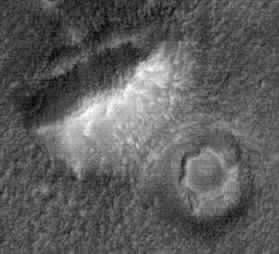
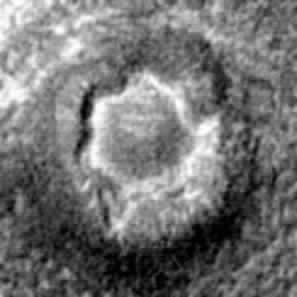
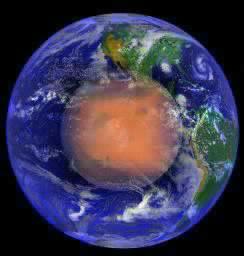
Cydonia Quest
C
Image Enhancements
C
The "Hexagon"
At the end of January 2001 MSSS released a new batch of Cydonia images to co-incide with the announcement that the main part of the MGS mission is now completed. (The MGS will now concentrate on looking at possible landing sites for future Mars missions). Amongst the features captured on the new images were the North West corner of the "Face" and (for the first time by MGS) the "Cliff". TEM's "Giza" style pyramid, the "Hexagon" and some of the "Southern Suburbs" were also re-imaged at a higher resolution in image M22-00378. A link to the new images can be found here, µµµ.


C
C
C
C
C
C
C
C
C
Speculations about the "Hexagon" seem to have first appeared on the internet on Mike Bara's Lunaranomalies web-site back in 1998. As the images to the left and right above show, it is adjacent to Bright Mound "P" and also close by the "Giza" style pyramid (off the picture to the North). In the 1998 MGS image of the "Hexagon" it appears as an anomalous walled structure sitting within a wide, non-circular moat. Its outline is certainly polygonal, but whether it is an actual hexagon is in the eye of the beholder (much like Cydonia Quest's own hexagonal description of the "Rotunda" µµµ). As the enlargement reveals, there seemed to be tantalising glimpses of fine structures both in the "Hexagon" and in its moat.
Whereas the "Giza" style pyramid and Bright Mound "P" appear much the same in the new higher resolution image as they did in 1998, the "Hexagon" has become a much, much more interesting feature. The "Hexagon" turns out to be a very complicated and artificial looking structure as revealed in the images below. (As these images have been compressed into JPEG format with its attendant "prism glass" effect, I find the best viewing distance is at least 3 feet from eye to monitor screen). One is immediately impressed by the fine network of reflective "ribs" that radiate from the bottom of the "Hexagon's" walls to the edge of the moat, before disappearing into the ground. On the right side of the moat (as seen in the images below) there is also a suspiciously neat array of geometric blocks. It can just be made out that sections of the outer wall of the "Hexagon" are multi-levelled with outer and inner sections of wall. In the interior of the "Hexagon" parallel "shelves" appear to be descending in steps from the northern wall into the "Hexagon's" rubble filled central bowl. The overall impression is that one is looking at the ruins of something architectural, even though the former function of such a structure is difficult to discern.
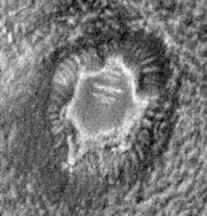
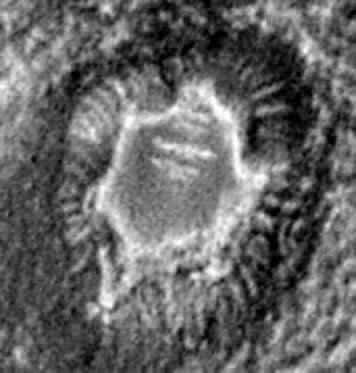
C
C
C
C
C
C
C
Was the "Hexagon" once covered by a dome? There is nothing in the "Hexagon" image to support this proposition. However, there is another feature in the new image strip that sits in the centre of a sharply defined moat which suggests that the "Hexagon" may once have been protected by a dome. This is a moated dome around two thirds the diameter of the "Hexagon". It is shown in the images below. Of course there is no way of ascertaining from the MGS image whether or not this dome actually contains a hollow interior space - but could it contain structures just as interesting as the "Hexagon": and could such hypothetical contents still be in pristine condition?
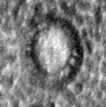
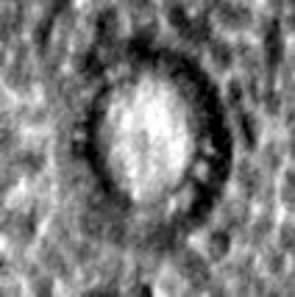
C
Technical comments. Details about the resolution of the new image of the "Hexagon" were not available at the time of writing, but it appears to be between 5 and 6 feet. Just as the 1998 image (now renumbered SP1-23903) of the "Hexagon" suffered from atmospheric haze, the new higher resolution image seems to have its own problems. As with the new image of the "Face" the picture is covered with a mesh of black speckles that have to be removed from the image before attempting to enhance and enlarge. I have found that Corel Photo-Paint 9's "jaggy despeckler" works very well on this. All the images above have been contrast enhanced. The smaller version of each image is the size as it appears in the MSSS published format - these are then enlarged by a factor of two by interpolation.
µ Next Page
µ Return to the Enhancements page